Moog’s patchable Grandmother and Matriarch just got black-panel makeovers, so they look like the historic 900-series modules that inspired them. And today, we kick off a series that uses this instrument to teach modular synthesis as musical technique – for beginners and advanced players alike.
Matriarch Dark
Okay, so there’s a new Matriarch and Grandmother. And they’re darker. But apart from aesthetics, the two versions each do tell a story, which we’ll be unpacking in detail to understand from both the perspective of engineering and musicianship.
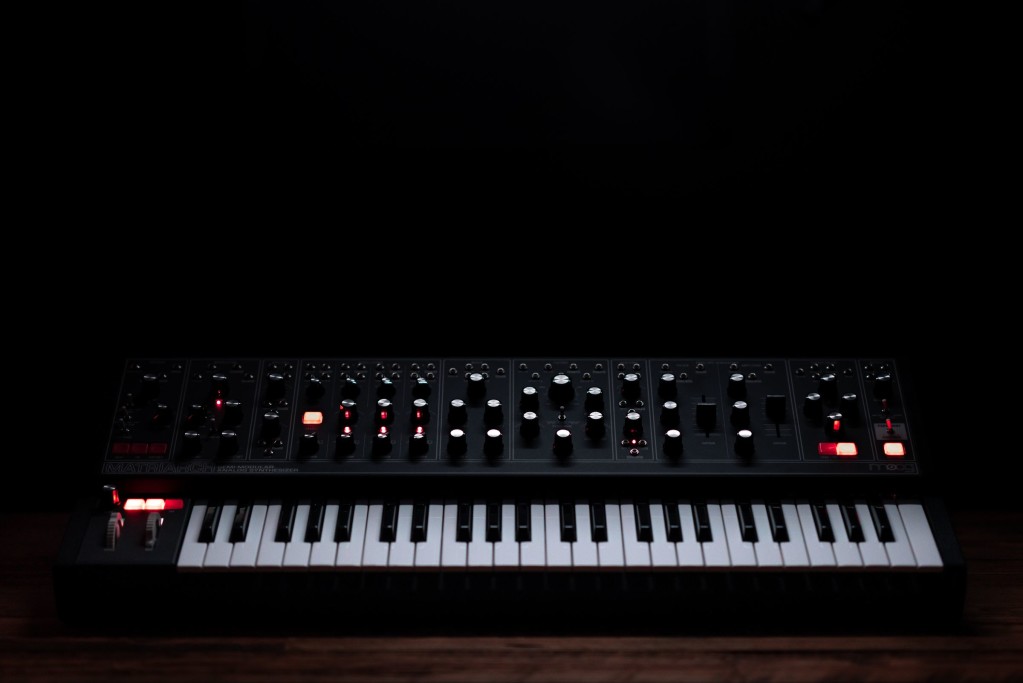
The original Matriarch‘s calico-colored panel connects it to the earlier modular keyboard from Moog, Grandmother. Aside from appealing to those who like bright pastels, those multiple colors delineated the different modules of the synth and said, hey, this is actually a modular in keyboard form. That’s a delay and a filter and a mixer and modulation and envelopes, and you can patch them if you want.
The black Matriarch and Grandmother look more traditional, but also make it clear that these synths are directly descended from the 900-series modular – a classic early generation of Moog modules. (Here’s an ancient but very useful page detailing their operation.) Before the Minimoog, modules were what defined the Moog sound – and they’ve remained definitive since. (That’s also the source of the phrase “East Coast modular” since Moog was in New York State, though Moog’s influence wasn’t confined to the eastern seaboard.)
You get two options – and they’re not terrifically expensive, either (plus a lot more affordable than a lot of Eurorack solutions to building up these basics):
Grandmother Dark recommended retail €999
Matriarch Dark RRP €1999
This new vintage-style black panel should drive home that point – it isn’t just a marketing connection to those modules, but reflective of what’s under the hood. The Matriarch’s engineering is closely related to those historical modules, down to some very precise implementation details, even as they’re combined into a new instrument. I spoke with Mark Crowley at Moog (see below), who led that engineering effort, to get both specifics and an understanding of how you can apply that engineering knowledge when you play.
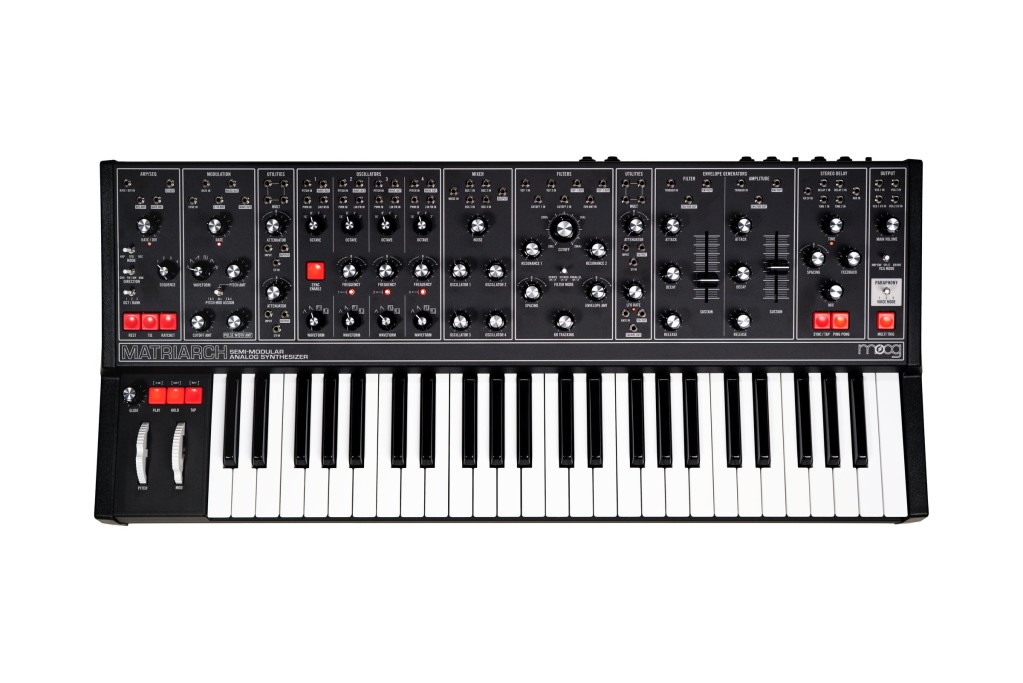
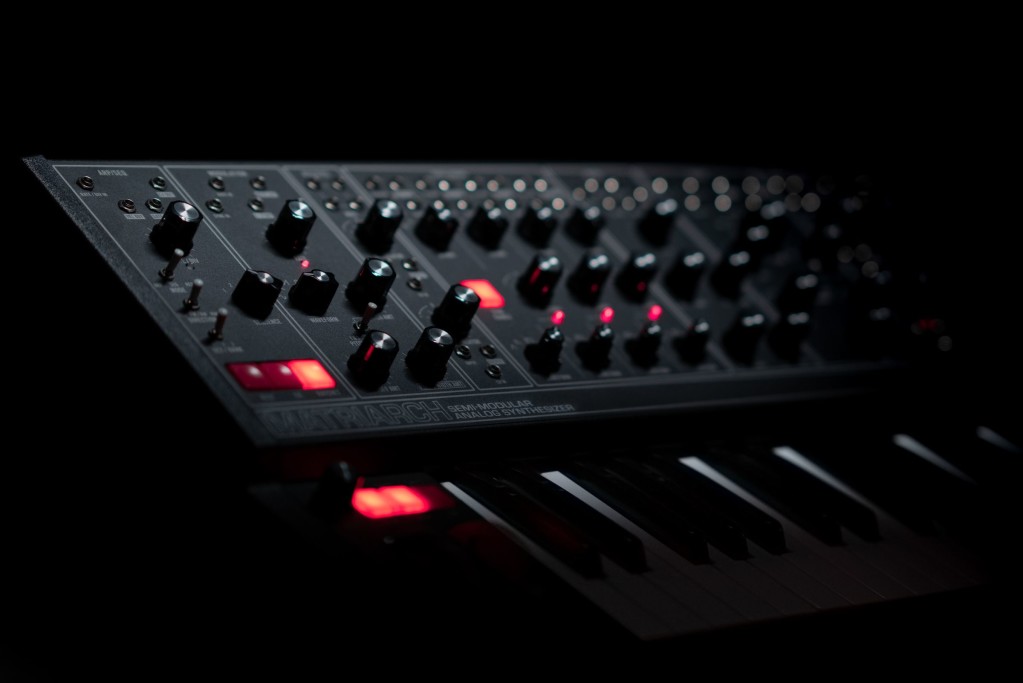
Ultimately, that’s what makes the Matriarch unique. It isn’t just a recreation of a 900-modular or a modular rack in a keyboard. It also isn’t simply a synth with some patch points added to make it “semi-modular.” It really is a coherent instrument built around a selection of modules, integrated in a way that they work together. You can patch it with other analog gear or a Eurorack modular or connect instruments. But there’s a unique experience to using a pre-designed modular (modular in routing, but not in the sense of bits that you bolt in and mix and match).
And that’s where I wanted to work with Moog on a deep dive into the instrument and how to patch it. We’ll use this to talk about some general techniques for using modular instruments and patching. Those techniques are meaningful anywhere, not only on the Matriarch. But the Moog gives us a great palette on which to hear and see them. I also invited Berlin-based producer and performer Lars Hemmerling to share some of his expertise and musicality. And we talked to the engineers who actually designed the thing.
As a teaser of some of what we were playing with, here’s a live jam (using a patch from Lars, with me playing for a while with a melody fragment he brought out) – an extra clip from our first video shoot. Lots more to come:
Welcome to our first Master Class series on CDM. And let’s start from the inside out.
Inside the Matriarch, with an engineer
Mark Crowley, Moog Hardware Engineer, actually worked on the design of the circuitry inside the Matriarch. So it’s a pleasure to hear not only how he thought about that, but how he plays the instrument he worked on. Here it is, part by part.
Relationship to Grandmother and vintage 900 modules.
“Analog” on its own isn’t so meaningful – it’s how it’s used. What strikes me about the Matriarch is the sense of how it has a particular color as you connect inputs – whether you turn down the gain or crank and overdrive signals, or anywhere in between. This is partly a result of the internal circuitry. It’s also worth noting that this carries on the legacy of the Minimoog Voyager that Bob had such a deep influence on, and that brought back Moog as a synth maker.
I’ll let Mark explain.
There’s a lot here, but don’t feel overwhelmed or worry if you don’t follow right away. We’ll go into some details translating how to approach this on the instrument in the coming installments of this series.
The philosophy of the system. I really enjoy free-form modular – whether in software or hardware. But even I was struck by having a coherent single system. I asked Mark about that approach, and he repeated basically that take:
I think what really works well in Matriarch is that it’s a large (semi-)modular system with a keyboard that benefits from the fact that because we had control over every part (unlike in a Eurorack system) it naturally gets tuned to be voiced and work well as an instrument. Plus the semi-modular nature of it means you can always unplug cables get back to basics.
Coming from the vintage modular designs we wanted to keep the methodology and workflow of “what you see is what you get” along with the flexibility of a modular synthesizer. Being a whole system we could implement the firmware to allow the sometimes annoying parts of modular, like tuning your oscillators, to be immediate and intuitive (without removing the range of non-traditional modular type sounds from the palette of the instrument). Hopefully, this minimizes moments that break musicians’ flow and allow the experience of playing the instrument to be more fluid.
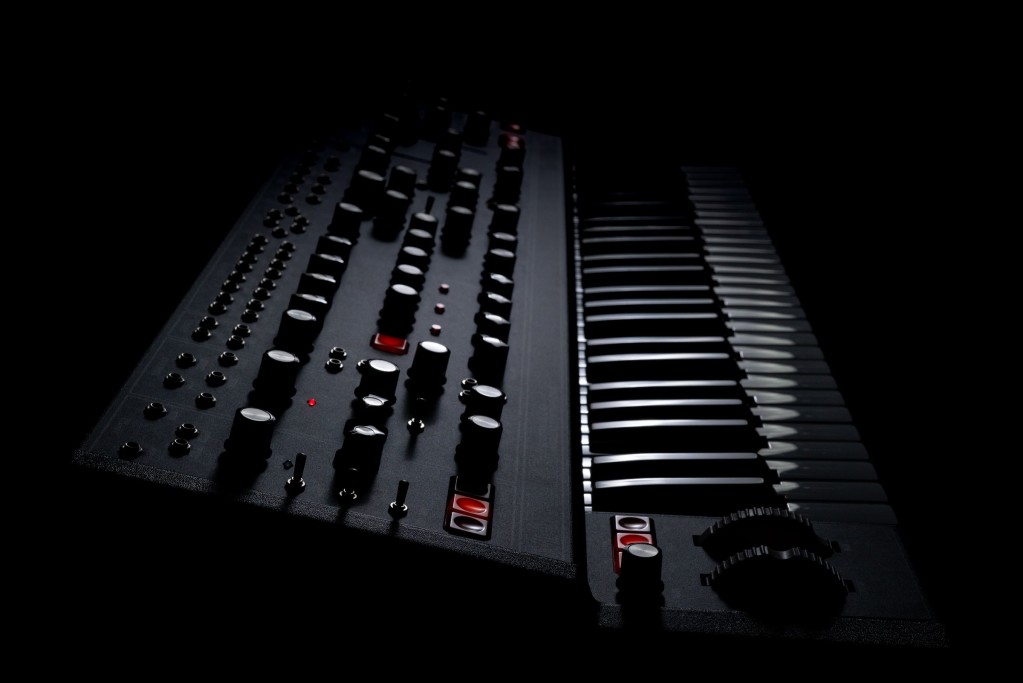
How it’s related to vintage Moog, and how it has evolved. There’s real vintage inspiration, and it hits in specific ways you’ll notice as you spend more time:
The discrete transistor buffers were kept from the vintage circuits. They color the inputs of the vintage modules and as a result, were left in the design.
The vintage-based modules are pretty much the same between Grandmother and Matriarch. The big difference is the high-pass implementation of Matriarch’s VCF1 [filter], which is similar to the [Minimoog] Voyager but with resonance.
There were also a few minor changes on the envelopes. They’re both analog envelopes based on the [vintage] 911 module but in Grandmother, the release stage was changed to be voltage-controlled so that it and the keyboard release envelope could share the release knob. In Matriarch, the ENV END OUT was added (which allows you to loop it as an Attack/Decay envelope for another modulation source, or have one envelope trigger the other). Obviously, the analog delay was a larger addition, and it is based on our 500 series Delay.
Multiple modes for amplitude control and signal attenuation:
The VCA CVs have different behavior depending on the VCA Modes. In ENV and SPLIT modes, they control the input drive to the 902 VCA, while the envelopes are sent as CVs to the 902 VCA. So you can patch a DC voltage into the VCA CV IN to drive those input buffers. This also allows you to get AM or Tremolo sounds when playing in the Envelope modes. In DRONE mode the jacks are just CV in controls for the 902 (rather than the input level)
Because the Attenuator CV IN is summed with the knob position you can get gain if you patch a DC signal into the CV in and adjust the knob. Try taking the output of the Mixer to an Attenuator then to the VCF Ins. Use another Attenuator to insert the DC signal into the CV in. You can of course also use this to drive the Input of the Delay from the Eurorack Ins. This has enough to get Opamp clipping in the Attenuator, so be mindful of that (sometimes it’s nice to have another flavor of distortion or using it to adjust the symmetry and clipping of signals being multiplied or ring modulated. )
Patching tricks:
We also added some of the normalled jacks on Matriarch because of the amount of patching that could be done and the fact that there were only 2 four-way mults. The Oscillator’s Pitch IN’s are daisy-chained and the Cutoff Ins and Delay Time and Feedback Ins being normalled so if you only plug into say, Cutoff 1 both are affected.
Where digital matters. Unlike something like Moog’s rarified modular recreations, the Matriarch – like Bob’s approach on the Voyager – does combine traditional techniques with modern digital control, says Mark:
Obviously, firmware was also implemented in places where the advantages of digital outweighed analog. Some examples are the quantization and timing of the sequencer and arpeggiator, the keyboard and MIDI implementation note allocation in the paraphonic modes, or in the delay, where the BBDs [analog Bucket Brigade Delays] have to be clocked by square wave and you can gain all kinds of benefits in terms of syncing the delay times.
So as on the 1981 Moogs we mentioned yesterday or Dave Smith’s creations, digital control of analog is essential.

Working with patching and levels
The Mixer module on the Matriarch/Grandmother is a lot of fun to play with, in ways I’ll talk about in other series – something you use creatively and for color as well as for, uh, mixing. But you’ll notice it doesn’t have control voltage inputs for setting mixer levels with signal – just the knobs. So I talked to Mark about how you’d use modulation signals.
The easiest example is just patching an LFO into a spare mixer channel just to modulate the DC offset of the signals being mixed and therefore any clipping that happens. Also I like to patch envelopes in there so that you can have distortion only on the attack of a note or something, I do this a lot for Rhodes type patches. The extreme of this is you can use an envelope and a DC signal to force the mixer to peg at a rail. Then when the envelope fires the audio will pass though making it a weird distorted pseudo-VCA.
Though there are no CV control inputs of the mixer, hopefully you can get close to what you’re after using a couple of tricks. The oscillators can be passively mixed in a mult. Also because of the way the normalling works, if you just patch two oscillators outputs together they will both appear mixed at both of their respective channels in the Mixer (gaining you a channel if you need it). This coupled with the Attenuators, which can be used as VCAs, and the fact that the left two are normalled together to mix at the output of the bottom one (if you don’t patch out of the output of the first) gives some options with some clever patching to manipulate the input levels to the mixer.
This was just kind of a case where you have to stop somewhere, and can’t include everything.
Also, there actually are VCAs before each oscillator channel of the mixer, but they’re just set up to open like gates with the key presses, arpeggiator, and sequencer (with slight attack and release to avoid popping). This can be cool for patching using the sequencer and keyboard if you patch other things into these channels
Splitting signal and stereo
The Matriarch and Grandmother look more vanilla than they actually are. Looking at the Matriarch, we found there are some sophisticated, deep choices for routing and splitting signals and using stereo field. Mark:
Yeah, one cool thing is to send two oscillators to one filter and two oscillators to another. In stereo low pass mode, you can have kind of two parallel two-oscillator mono synths, which can get you a really wide stereo field because the oscillators will naturally be out of phase. Then you can use out of phase stereo filter modulation by multing the output [patching through the MULTI] of an LFO and sending it to VCF1 Cutoff In and inverting it with an attenuator to send to VCF2 Cutoff in. (doing the same with the VCAs will get you typical panning or stereo AM). Modulating the rate of an LFO patched like this with an envelope can be fun.
Then obviously you have the whole Stereo Delay that you can patch the left and right channels fully independently, in dual mono or ping pong, so it can get pretty wild in terms of the stereo field. The other day I was modulating the left and right feedbacks and times slowly out of phase which was fun.
Hidden mode/tip: Paraphonic Unison
So there’s a “Paraphonic Unison” mode. When you hold multitrig while switching paraphony you toggle between this and the default mode. In the default mode every key you press gets a single oscillator, so if you only press one key you only hear one oscillator. In paraphonic unison you always hear all four oscillators. As a result if you press one key, it behaves like it’s in mono mode, if you play two it splits the oscillators two to a note, three keys means each note gets an oscillator except one gets two oscillator, and four will behave identically to the default paraphonic mode. It’s fun to switch between this and the normal paraphonic mode especially if you have varied amounts of harmony per step in a sequence.
I’ve got more specific modulation tricks from Mark which we’ll look at later. But let’s finish with some more music – which also grows out of unique approaches to patching.
Lisa Bella Donna music

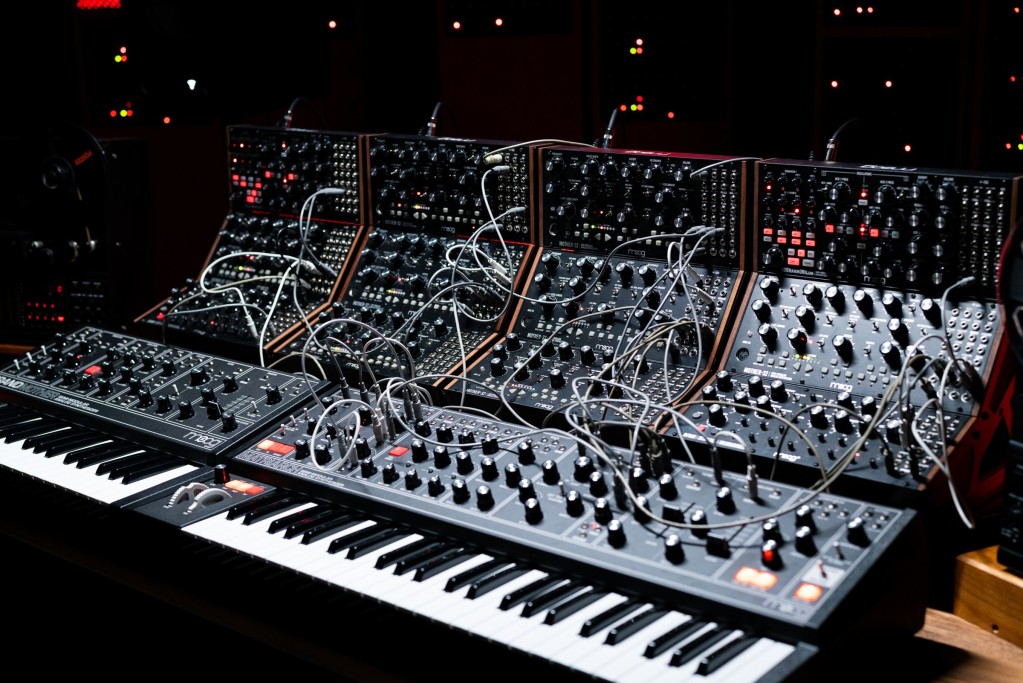
Artist in residence Lisa Bella Donna is making spectacular use of all that Moog gear – the way we would if any of us had anything like this. But we talked a lot about how she works with routing in external gear – also including ARP Omni and 2600. She emphasized that in her teaching, she encourages students to turn down the Mixer module and not overdrive everything all the time. But she’s also an expert in using the Matriarch as a command center, and in creatively routing in modulation. She sends us this example:
Moog Mothers controlling the pitch and modulation of the matriarch. Matriarch mixer in full color.
A 2 track recording. Matriarch to Otari mx5050.
Lisa also has this terrific performance, released officially by Moog:
More music:
That’s all for today – probably enough to chew on.
Tune in next time, as we’ll start at the very beginning of how to work with modulation on the Matriarch (and other synths, too!)